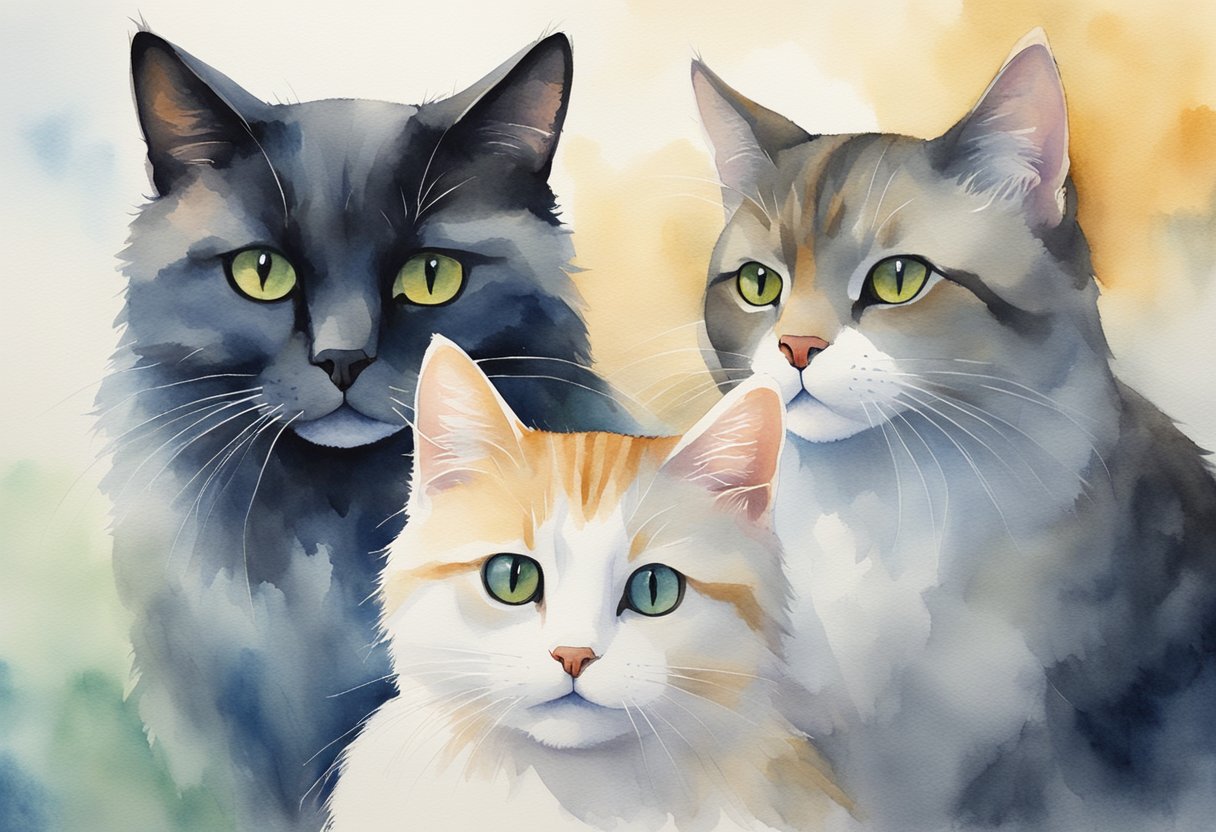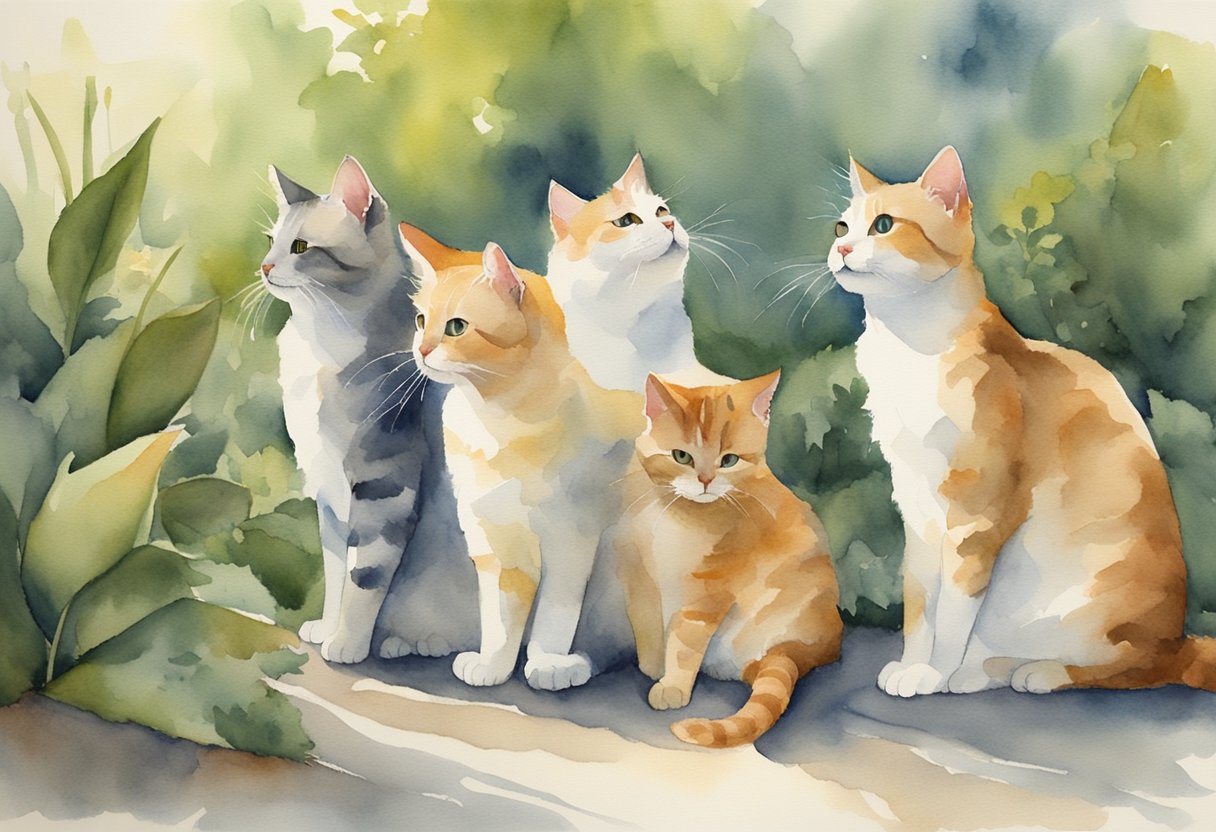Cats are known for their independent nature, and unlike dogs, they generally do not form packs with a strict social hierarchy. However, you’ll find that they can and do establish complex social structures, particularly in outdoor or feral communities.
Take for example feral cats, who often coexist in groups sometimes referred to as colonies. The dynamic within these groups is usually centered around the availability of resources. The harmony of these colonies often hinges on factors such as familiarity and food availability, with dominant individuals sometimes emerging, particularly in female-led groups.

When observing domesticated cats, you may notice they tend to be more solitary but are quite capable of forming close bonds and affiliations with other household pets, including other cats.
These relationships are usually formed based on individual personalities and past experiences with socialization. You may have seen cats grooming each other or sleeping in close proximity, which are signs of mutual acceptance and social connection.
Your own home might not showcase the dramatic dynamics of a wild cat colony, but if you have more than one cat, you may notice subtle social interactions. These interactions can range from shared mealtimes to a preferred order for playtime or lounging spots.
While it’s not exactly a pack in the wild sense, these behaviors are indicative of your cats’ understanding of their social environment.
Cat Social and Territorial Dynamics

In exploring cat social and territorial dynamics, you’ll uncover the complexities of how domestic cats interact with each other and their environments. From their social structures to the way they mark and maintain territories, you’re about to see there’s more to your cat’s behavior than meets the eye.
Understanding Feline Social Structures
Cats have a social system that’s both intricate and adaptable. Unlike the pack hierarchies seen in dogs, domestic cats will often live in looser associations. These groups can range from single territorial cats to larger cat colonies often observed in feral cats.
Social organization within these groups is usually loose, but a social hierarchy may be present, where more dominant individuals assert precedence, particularly when it comes to access to food and shelter.
Territorial Behavior and Communication
Your cat is a master of territorial behavior. Territory is more than just space; it’s a resource for which cats may show territorial behavior. This includes scent marking with urine or body language, such as hissing to warn others.
Scent marking is crucial for communicating boundaries, with litter boxes, garden beds, or even your favorite chair serving as potential markers within your home.
The Role of Resources and Space
Within a cat’s territory, vital resources like food, hunting territory, and shelter are paramount. Feral cats often form colonies around plentiful resources, which can lead to visible social structures.
For domestic cats, the placement of resources such as food bowls and litter boxes can significantly influence their perception of space and territory within your home. These resources can either promote peace or trigger disputes, depending on how they’re managed.
Interactions and Relationships
You’ll discover that feline interactions and relationships are complex, weaving together behaviors such as communication, bonds, and hierarchies.
Inter-Cat Relationships
In a multi-cat household, you will observe a range of interactions that form the tapestry of a cat’s social life. Communication is a cornerstone, with cats using vocalizations like meowing or growling, as well as non-vocal cues like tail flicks or ear positions, to express themselves.
Relationships between cats can be formed through allogrooming (mutual grooming), offering comfort and support to each other, particularly between families or those that share a strong bond. These social bonds can extend to mating partnerships or matrilinear structures, often seen with kittens and their queen.
While not always evident, social interactions among felines can signify complex relationships that can influence their hierarchical social structures.
- Communication Methods:
- Vocal: meows, purrs, hisses
- Body Language: tail flicks, ear position, rubbing
- Bonding Behaviors:
- Allogrooming
- Sleeping together
- Playing
Do Cats Have Hierarchy?
Unlike dogs, cats don’t typically form strict packs, but they do have a form of social structure that could resemble a hierarchy, albeit more fluid. In a household, you might notice one cat asserting dominance over resources like food dishes or favorite resting spots—a subtle competition that underscores their instinctual drive, inherited from their wild ancestors like the tiger or lion.
This hierarchy can be more pronounced in multi-cat households, where access to resources and personal space is necessary. Aggressive behaviors can emerge when these hierarchies are challenged, so it’s important to ensure all your pets have what they need to feel secure.
- Signs of Hierarchical Structure:
- Dominance over food or toys
- Aggression or fighting over territory
- Preference for high vantage points

My name is James, and welcome to FAQCats!
Along with our team of cat owners, expert pet enthusiasts, and pet professionals, we aim to write engaging helpful, engaging content about cats. At FAQCats we strive to provide content that’s accurate and fun to read. Our team writes about everything related to cats; even the most complex of topics. Through extensive research and caring for our own fur-pals, we’re able to provide something cat owners worldwide will love. Have a look around, and leave us feedback anytime!

